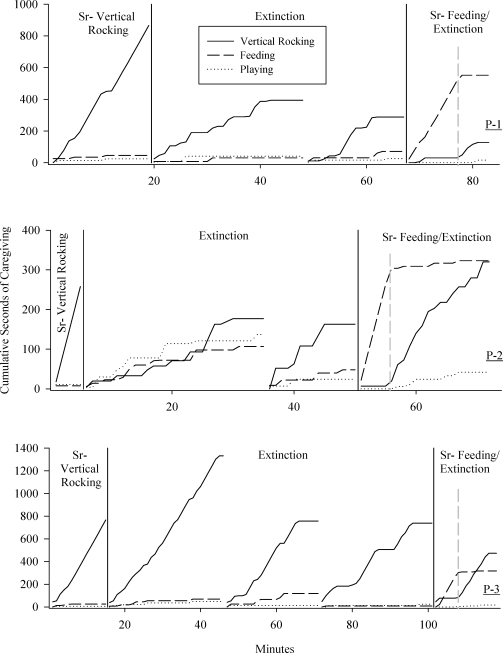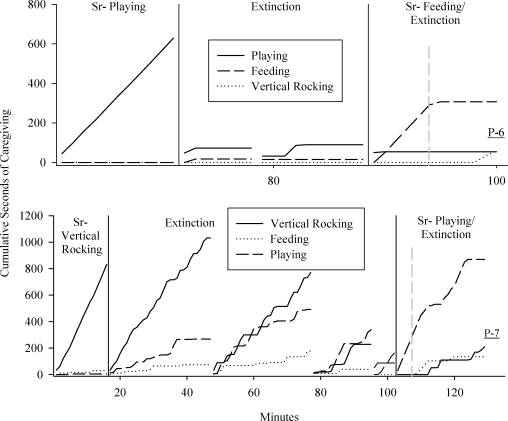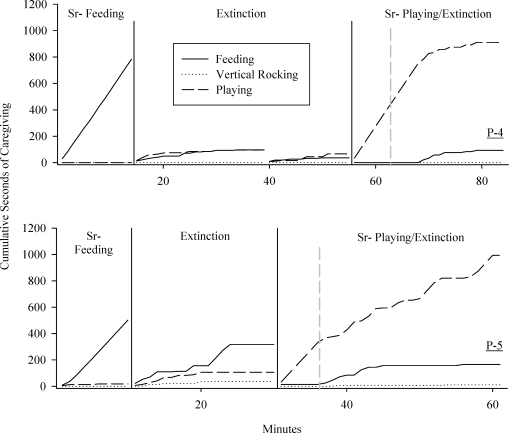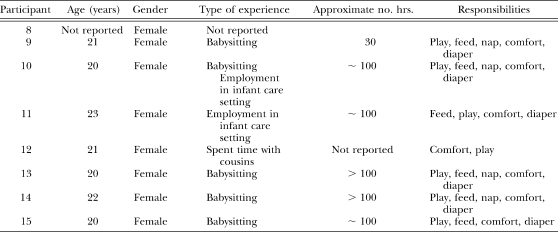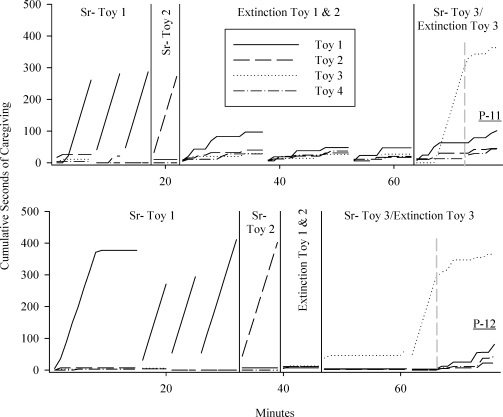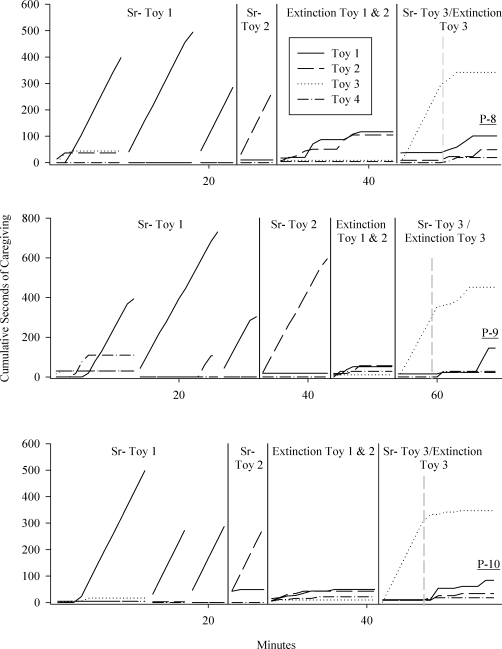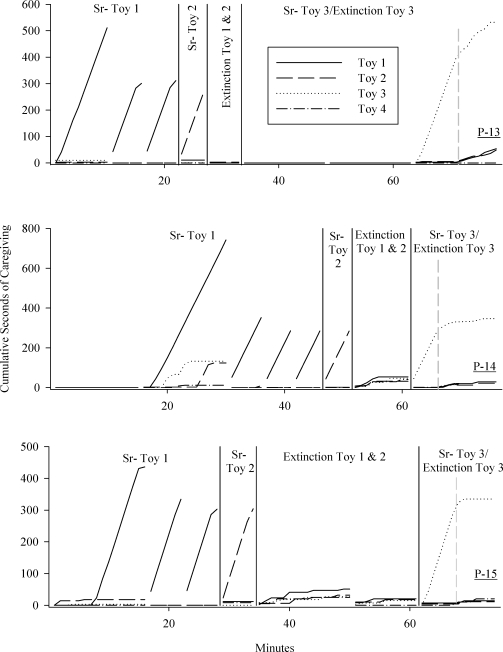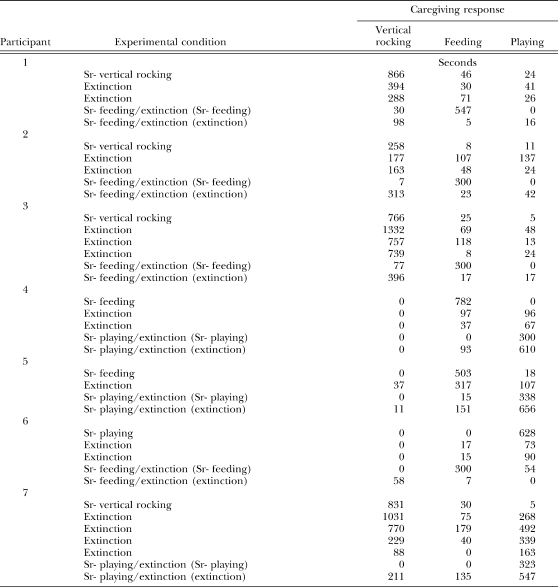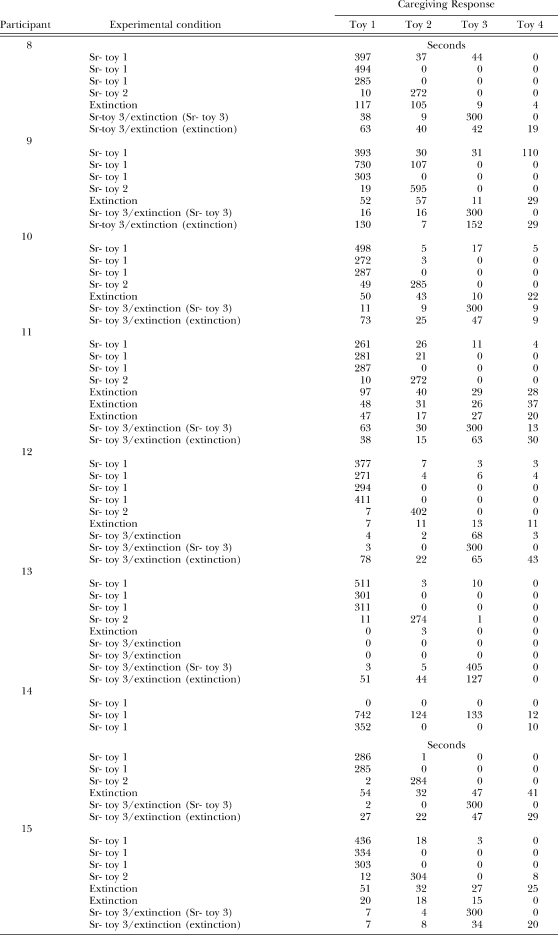Abstract
Two experiments were conducted to identify the conditions likely to produce resurgence among adult human participants. The preparation was a simulated caregiving context, wherein a recorded infant cry sounded and was terminated contingent upon targeted caregiving responses. Results of Experiment 1 demonstrated resurgence with human participants in this negative reinforcement preparation. Results of Experiment 2 showed that responses with a longer history of reinforcement showed a stronger resurgence effect relative to responses with a shorter and more recent history of reinforcement. These results show that the resurgence phenomenon occurs across populations and types of reinforcers. Additionally, results indicate that length of reinforcement history is a variable that may affect the magnitude of resurgence.
Keywords: extinction, negative reinforcement, resurgence, humans
Resurgence, the reemergence of a previously (but not currently) reinforced response when a subsequently reinforced response is placed on extinction, is understudied relative to other extinction-related phenomena (e.g., bursts, emotional behavior, spontaneous recovery; Lerman & Iwata, 1996). Yet, as Lieving and Lattal (2003) suggest, resurgence may play a role in problem solving and creativity and may serve as one experimental model of clinical relapse. In each of these examples, a previously reinforced response may reemerge when more recently reinforced responses no longer satisfy the current contingency.
Although the studies are limited in scope, researchers have observed possible resurgence effects with problem behavior in clinical settings. Goh and Iwata (1994) and Lieving, Hagopian, Long, and O'Connor (2004) illustrate two possible clinical examples of resurgence of severe problem behavior among individuals with developmental disabilities. In both studies, a previously observed form of problem behavior (e.g., aggression) recovered when extinction was applied to a different topography of problem behavior (e.g., self-injury). However, given the clinical nature of these investigations, these studies did not include all controls necessary to draw definitive conclusions regarding the variables controlling increases in problem behavior under extinction. For example, although Lieving et al. programmed reinforcement for all topographies of problem behavior during baseline, only one topography of problem behavior occurred under this condition. Therefore, there was no experimental history of reinforcement for responses that emerged under extinction. Given these limitations, additional research including human participants is needed to establish the generality of the resurgence phenomenon and to understand the historical variables that contribute to resurgence.
Research with nonhumans has shed some light on historical variables that influence resurgence. Although results of several studies support the Response Prevention Hypothesis, which suggests that the degree of resurgence of a response is a function of the degree of extinction of that response (Cleland, Foster, & Temple, 2000; Leitenberg, Rawson, & Mulick, 1975; Rawson, Leitenberg, Mulick, & Lefebvre, 1977) some studies have shown resurgence even when the recovered response is allowed to undergo extinction (Epstein, 1983; Lieving & Lattal, 2003). Similarly, Lieving and Lattal's results showed that recency of reinforcement history for the recovered response did not appear to influence the magnitude of resurgence. After reinforcing and extinguishing key pecking, the researchers reinforced treadle presses for 5 or 30 sessions across groups of pigeons; the degree of resurgence of key pecking in a subsequent extinction condition was similar across these two groups. More recent research suggests that response rates prior to extinction may be a better predictor of resurgence than rate of reinforcement. Da Silva, Maxwell, and Lattal (2008) differentially reinforced high and low rates of responding by rats on two different keys and found that key presses that occurred more frequently were more likely to resurge, even when reinforcement rates were similar. Taken together, this research points to several variables contributing to resurgence, but the full range of historical variables that may contribute to resurgence has not yet been explored (see Lieving & Lattal).
Despite the fact that resurgence may contribute to a host of socially important behavioral phenomena, controlled studies of resurgence have included primarily nonhuman subjects. Therefore, a purpose of the current study was to examine resurgence with human participants. Additionally, to date, experimental studies of resurgence have exclusively programmed positive reinforcement (e.g., Bachá-Méndez, Reid & Mendoza-Soylovna, 2007; Cleland et al., 2000; Da Silva et al., 2008; Epstein, 1983; Leitenberg et al., 1975; Lieving & Lattal, 2003; Rawson et al., 1977). A substantial portion of naturally occurring human behavior appears to be under aversive control, and negative reinforcement (the response-dependent removal of a stimulus, resulting in an increase in responding) has been studied extensively in the laboratory (e.g., Dinsmoor, 1977; Hineline & Rachlin, 1969; Rachlin, 1969). However, relatively little research has been devoted to exploring the role of negative reinforcement in socially important human behavior (Iwata, 1987). Therefore, a second purpose of this study was to describe the resurgence phenomenon when negative reinforcement is programmed with human participants.
In the current study, negative reinforcement for participant responses was programmed within a simulated infant caregiving context. Infant caregiving is one naturally occurring interaction that appears to involve, at least in part, negative reinforcement. Crying affects caregivers physiologically in ways similar to other noxious stimuli (e.g., increased heart rate; Frodi & Lamb, 1980; see Herd, 1991, for a comprehensive review), and in a series of studies by Donovan and colleagues (e.g., Donovan, 1981; Donovan & Leavitt, 1985) participants performed simple tasks that resulted in termination of a recorded infant cry. Thus, it seems likely that some forms of caregiving are shaped and maintained by negative reinforcement in the form of escape from and avoidance of infant crying. We simulated these contingencies by arranging for several caregiving responses directed toward a baby doll to result in termination of a recorded cry. Extinction conditions were designed to simulate a period of inconsolable crying.
GENERAL METHOD
Participants, Setting, and Materials
Participants were undergraduate students at the University of Kansas who received extra course credit for their participation. All sessions were conducted in a small therapy room (1.77 m x 2.45 m) equipped with a one-way mirror and an adjacent observation booth. Each session included materials designed to occasion target caregiving responses including a baby doll, a blanket, a bottle (Experiment 1 only), infant toys, a crib, a chair, and a cassette recorder that was located under the crib. The cassette recorder played a recorded infant cry (80 db) and was activated from the observation booth. The recording consisted of a crying episode (i.e., approximately 15 min) that was repeated continuously to accommodate the maximum duration of the session (i.e., longer than 30 min). The infant cry was recorded in a university-run daycare with consent from the infant's parents. The cry was recorded from a 9-month old infant during a routine care activity that often evoked crying from the infant.
Response Measurement and Interobserver Agreement
From the observation booth, data were collected on the duration of infant caregiving responses using handheld computers. The primary observer was a graduate student (either the first or third author) and the secondary observer was either a graduate or undergraduate student. For each response, scoring began when the participant performed the response for 3 consecutive s and stopped when that response ceased for 3 consecutive s.
Vertical rocking was defined as the participant holding the doll in her arms in a vertical position (baby doll's head between the neck and the middle of upper arm) with the baby doll's face/body facing the participant and moving the baby doll in a side-to-side or up-and-down motion (baby doll's head moving). Feeding (Experiment 1 only) was defined as the participant placing the bottle to the doll's mouth with at least one of the participant's hands on the bottle. Playing was defined as the participant placing a toy in the doll's visual field (i.e., in front of baby doll, above baby doll's waist) with at least one of the participants' hands on the toy.
Agreement was determined by dividing each session into 10-s intervals and comparing data collectors' records on an interval-by-interval basis. Within each interval, the smaller duration of caregiving responses recorded was divided by the larger duration of caregiving responses recorded (Cooper, Heron, & Heward, 2007). Nonoccurrence of behavior (i.e., “0” s within a 10-s interval) recorded by both observers was scored as an agreement (i.e., a score of “1”). These quotients were then averaged across intervals and multiplied by 100. Interobserver agreement percentages are reported for each experiment below.
Procedure
The participant entered the room approximately 2 min prior to the start of each session. Instructions delivered vocally by the experimenter to all participants before each session were:
We are conducting this study to learn how adults will respond in a simulated caregiving situation. Do what comes naturally. Please do not touch the lights or the sound receiver. We will knock on the window to indicate when the session begins and ends.
The maximum session duration was 30 min in Experiment 1 and 15 min in Experiment 2. However, during reinforcement conditions, sessions were terminated after 5 consecutive min of engagement in the target response (acquisition criterion), and during extinction conditions, sessions were terminated when the participant did not engage in the target response for 5 consecutive min (extinction criterion).
Target responses were randomly assigned to the first experimental condition prior to the start of the study. To increase the likelihood that target responses would contact the reinforcement contingency, target responses assigned in subsequent conditions were randomly selected from those that were exhibited at some level in previous conditions. One participant (i.e., P-6) did not engage in the response that was initially targeted for reinforcement during phase 1 for two sessions (i.e., vertical rocking, data not shown), therefore, the reinforcement contingency was reassigned to a target response (i.e., playing) that occurred at low levels when reinforcement was programmed for vertical rocking.
For each participant, a response never reinforced during the experiment was also measured and served as a control against which to compare the duration of previously reinforced responses in the resurgence test conditions. The control response was the response option not randomly selected as a target response (see above). An increase in a previously reinforced response above levels of the control response was considered resurgence. If previously reinforced responses and the control response increased at approximately the same magnitude, this pattern could not be attributed to a previous history of reinforcement and was thus not considered an example of resurgence in this experimental preparation (Epstein, 1983).
EXPERIMENT 1
Experiment 1 was conducted to identify whether resurgence would occur with human participants in a negative reinforcement arrangement. The preparation was a simulated caregiving context in which escape from a recorded infant cry was programmed for participant responses.
Method
Participants
Participants were 7 undergraduate students (5 females and 2 males) between the ages of 20 and 22 years old who reported varying levels of caregiving experience (i.e., experience ranged from none to over 100 hours; see Table 1).
Table 1.
Participant Profile and Caregiving Experience
| Participant | Age (years) | Gender | Type of Experience | Approximate no. hrs. | Responsibilities |
| 1 | 21 | Female | Babysitting, Nursery | < 20 | Play, feed, comfort, diaper |
| 2 | 21 | Female | Babysitting, cared for younger sibling | > 100 | Play, feed, nap, comfort, diaper |
| 3 | 20 | Female | Babysitting, cared for younger sibling | > 100 | Play, feed, nap, comfort, diaper |
| 4 | 21 | Male | No experience | ||
| 5 | 20 | Male | No experience | ||
| 6 | 20 | Female | Babysitting, employment in infant care setting | 10 | Play, feed, nap, comfort, diaper |
| 7 | 22 | Female | Babysitting, nannying | >100 | Play, feed, nap, comfort, diaper |
Interobserver Agreement
A second observer simultaneously but independently recorded data during a mean of 94% of sessions for each participant (range, 74% to 100%). Mean agreement across participants for all target responses was 97% (range, 87% to 100%).
Procedure
The following experimental conditions were used:
Negative Reinforcement (Sr−) response 1
The cry played at the start of the session, and was terminated only after the participant engaged in the target response (response 1) for 3 s. The cry resumed if the participant ceased to engage in the target response for 3 s. This experimental condition was repeated until the participant met the acquisition criterion in one session.
Extinction response 1
The cry was presented for the duration of the session, independent of participant responding. This experimental condition was repeated until the participant met the extinction criterion in one session (P-4 and P-5) or two consecutive sessions (P-1, P-2 P-3, P-6, and P-7). The number of extinction sessions at criterion was reduced to one session for P-4 and P-5 in an attempt to identify whether similar patterns of responding would occur with a more efficient experimental preparation. However, P-4 did not meet the extinction criterion in the first extinction session and was therefore exposed to two sessions of extinction.
Sr− response 2/Extinction response 2 (resurgence test)
The cry played at the start of the session, and was terminated only after the participant engaged in the target response (response 2) for 3 s. After the participant engaged in 5 continuous min of the target response, the target response (response 2) was placed on extinction; the cry was presented for the remaining duration of the session, independent of participant responding.
The transition from reinforcement of response 2 to extinction was programmed to occur within a session rather than at the start of a new session to avoid confounding the resurgence test with other behavior changes that may occur at the start of the session (e.g., spontaneous recovery; see Sidman, 1960, p. 310).
Results and Discussion
All participants acquired response 1 within one session (see Figures 1–3; each panel represents data from an individual participant). Participants who were required to meet the extinction criterion across two consecutive sessions (P-1, P-2, P-3, P-6, and P-7) completed the extinction phase in a maximum of four sessions (Figures 1 and 3). Participants who were required to meet the extinction criterion in only one session (P-4 and P-5) completed the extinction phase in one (P-5) or two (P-4) sessions (Figure 2).
Fig 1.
The cumulative duration of caregiving in seconds (y-axis) during Experiment 1 for Participants 1, 2, and 3. Data are depicted in 1-min bins along the x-axis, and breaks in the data paths indicate the start of a new session. Vertical dashed lines indicate the transition from reinforcement of a response to extinction during the resurgence test. Each panel represents data from an individual participant.
Fig 3.
The cumulative duration of caregiving in seconds (y-axis) during Experiment 1 for Participants 6 and 7. Other details as in Figure 1.
Fig 2.
The cumulative duration of caregiving in seconds (y-axis) during Experiment 1 for Participants 4 and 5. Other details as in Figure 1.
In the resurgence test condition, all participants acquired the second response within one session and, within that same session, the reemergence of the previously reinforced response (response 1) under extinction of response 2 was observed in 5 (those shown in Figures 1 and 2) of 7 participants. That is, after a period of reinforcement and the onset of extinction for response 2, the resurgence of response 1 (the response with an experimental history of reinforcement) was observed relative to the control response (a response with no experimental history of reinforcement). One participant (P-6) did not perform the previously reinforced response when exposed to extinction of response 2 (see Figure 3). One participant (P-7) showed an increase in the previously reinforced response and a similar increase in the control response (see Figure 3). Appendix A illustrates the total seconds of caregiving for each participant by condition and response in Experiment 1.
These findings are consistent with those obtained by Epstein (1983) and Lieving and Lattal (2003) who found that resurgence was obtained when the previously reinforced response was exposed to traditional extinction (i.e., no simultaneous reinforcement of a second response) prior to the resurgence test. Results from Epstein and Lieving and Lattal suggest that the degree of exposure to extinction does not affect the magnitude of resurgence, and results of Experiment 1 also are consistent with those findings. For example, P-5 was exposed to only one session of extinction of response 1, yet the magnitude of the resurgence of this response was similar to (P-1) or less than (P-2, P-3) the magnitude of resurgence observed with participants who experienced more exposure to extinction.
Additionally, these results serve as an experimental demonstration of resurgence of negatively reinforced human behavior. These data illustrate a common context, infant caregiving, in which negatively reinforced behavior comes into contact with extinction. In infant caregiving situations, caregivers often contact periods of extinction (i.e., inconsolable crying) for responses that had been previously reinforced in similar situations but are not effective in the current situation. These data suggest that, when this occurs, caregivers are likely to revert to responses that have been successful in terminating the cry in the past. Under naturally occurring caregiving conditions, resurgence may be beneficial if caregivers revert to previously effective and socially desirable forms of caregiving (e.g., singing) when one form of caregiving becomes ineffective (e.g., feeding). Resurgence would be detrimental with parents who have a history of successfully terminating crying episodes with rough handling. For example, in some cases of fatal infant shaking, perpetrators report that they had shaken the baby previously (Hoffman, 2005). Thus, caregiver responses to inconsolable crying represent one example of the importance of understanding the contribution of behavioral history to resurgence and other extinction-related phenomena.
A limitation of Experiment 1 is illustrated in the response pattern of P-7, who displayed similar increases in response 1 (vertical rocking, the previously reinforced response) and the control response (feeding) during the resurgence test. According to Epstein (1983), this pattern might be considered an increase in variability rather than resurgence because a response with a programmed experimental history of reinforcement and a response with no experimental history of reinforcement increased similarly when response 2 was placed on extinction. However, P-7 reported over 100 hours of caregiving experience during which she was responsible for feeding babies (see Table 1); thus there was an extraexperimental history of reinforcement for the control response. Therefore, an increase in the control response (i.e., feeding) during the resurgence test may have been an instance of resurgence of a response with a lengthier, but more temporally distant history of reinforcement. It should be noted that participants P-2 and P-3 also reported over 100 hours of caregiving that included playing with an infant; however, their levels of playing were low during the resurgence test relative to responses with an experimental history of reinforcement.
Despite the fact that response 1 was randomly assigned prior to the start of the experiment, it is possible that resurgence effects observed with some participants were a result of differential extraexperimental histories of reinforcement associated with various responses. Given that a goal of our preparation was to simulate naturally occurring caregiving conditions, it would have been difficult to select responses with no extraexperimental history of reinforcement. Therefore, in Experiment 2, we attempted to select responses that were likely to be associated with equal extraexperimental histories of reinforcement.
EXPERIMENT 2
The results for one participant (P-7) in Experiment 1 suggested that a response presumed to be associated with a lengthier but more temporally distant (and extraexperimental) history of reinforcement showed the same pattern of resurgence as a response with a recent experimental history of reinforcement. Thus, the purpose of Experiment 2 was to evaluate the effects of length and recency of reinforcement history on responding during the resurgence condition. In order to minimize the intrusion of extraexperimental reinforcement history, target and control responses consisted of four distinct yet topographically similar responses that each involved toy play directed toward the baby doll.
Method
Participants and Materials
Participants were 8 undergraduate students between the ages of 20 and 23 years old (see Table 2). Materials were a baby doll, a blanket, four infant toys (puppet, rattle, mirror, and block), a crib, a chair, and a sound receiver.
Table 2.
Participant Profile and Caregiving Experience
| Participant | Age (years) | Gender | Type of experience | Approximate no. hrs. | Responsibilities |
| 8 | Not reported | Female | Not reported | ||
| 9 | 21 | Female | Babysitting | 30 | Play, feed, nap, comfort, diaper |
| 10 | 20 | Female | Babysitting Employment in infant care setting | ∼ 100 | Play, feed, nap, comfort, diaper |
| 11 | 23 | Female | Employment in infant care setting | ∼ 100 | Feed, play, comfort, diaper |
| 12 | 21 | Female | Spent time with cousins | Not reported | Comfort, play |
| 13 | 20 | Female | Babysitting | > 100 | Play, feed, nap, comfort, diaper |
| 14 | 22 | Female | Babysitting | > 100 | Play, feed, nap, comfort, diaper |
| 15 | 20 | Female | Babysitting | ∼ 100 | Play, feed, comfort, diaper |
Response Measurement and Interobserver Agreement
The duration of playing (defined in general method) with each of the four infant toys was measured separately. A second observer simultaneously but independently recorded data during a mean of 62% of sessions for each participant (range, 36% to 100%). Mean agreement across participants for all target responses was 97% (range, 85% to 100%).
Procedure
Experimental Conditions
Sr− toy 1 (lengthier history)
Response 1 was reinforced using procedures identical to those used in the negative reinforcement condition in Experiment 1. However, to establish a relatively lengthier history, this experimental condition continued until the participant engaged in the target response for 5 continuous min during three consecutive sessions.
Sr− toy 2 (more recent history)
Response 2 was reinforced using procedures identical to those used in the negative reinforcement condition in Experiment 1. This experimental condition was conducted until the participant engaged in the target response for 5 continuous min for only one session, creating a relatively shorter, but more recent, history of reinforcement compared to that associated with response 1.
Extinction toys 1 and 2
The recorded infant cry was played for the duration of the session, independent of participant responding. This condition continued until the extinction criterion was met for both response 1 and response 2 in one session.
Sr− toy 3/Extinction toy 3 (resurgence test)
A third response was reinforced and then placed on extinction using the procedures described in the resurgence test in Experiment 1. For two participants (P-12 and P-13), this condition was repeated because the reinforcement criterion was not met in the initial resurgence test conditions (see Figure 5).
Fig 5.
The cumulative duration of caregiving in seconds (y-axis) during Experiment 2 for Participants 11 and 12. Other details as in Figure 1.
Results and Discussion
The lengthier history of reinforcement for response 1 (three consecutive sessions with 5 continuous min of engagement in the target response) was established within five sessions (see Figures 4–6). The shorter but more recent history of reinforcement was established within one session (see Figures 4–6). When extinction was applied to responses 1 and 2, all participants met the extinction criterion (one session with 5 min of continuous nonengagement in the responses targeted for extinction) within three sessions (see Figures 4–6). In the resurgence test condition, participants acquired the third response in between one and three sessions. When response 3 was placed on extinction during the resurgence test, 5 of 8 participants displayed the highest levels of response 1 (lengthier, but more temporally distant history) relative to response 2 (more recent history) and the control response. One participant (P-13) performed responses 1 and 2 (both responses with some experimental history of reinforcement) at approximately equal durations (see Figure 6), but did not engage in the control response. Two participants (P-14 and P-15) showed an increase in both responses with a history of reinforcement (i.e., responses 1 and 2) and an increase in the control response (see Figure 6). No participants displayed a higher level of the most recently reinforced response during the resurgence test. Appendix B illustrates the total seconds of caregiving for each participant by condition and response in Experiment 2.
Fig 4.
The cumulative duration of caregiving in seconds (y-axis) during Experiment 2 for Participants 8, 9, and 10. Other details as in Figure 1.
Fig 6.
The cumulative duration of caregiving in seconds (y-axis) during Experiment 2 for Participants 13, 14, and 15. Other details as in Figure 1.
These results are consistent with the findings of Lieving and Lattal (2003). These authors examined the effects of the recency of the reinforcement contingency for response 1 by manipulating the amount of time that response 2 was reinforced (i.e., 5 vs. 30 days), and found that reinforcement recency had no effect on the magnitude of resurgence. That is, response 1 resurged with a similar magnitude regardless of the duration of exposure to reinforcement of response 2. Together, the results of the Lieving and Lattal study and the current study suggest that recency of reinforcement for a particular response may have little effect on the magnitude of resurgence.
By contrast, results of the current study suggest that the length of reinforcement history may affect resurgence. Responses with a longer (but more temporally distant) history of reinforcement were, overall, more likely to resurge than responses that were more recently reinforced. However, a limitation of Experiment 2 is that the lengthier history was always arranged for response 1. Therefore, length of history is confounded with primacy. Reed and Morgan (2006) trained rats to emit a series of three-response sequences (consisting of different patterns of lever-pressing responses) and found that, after response sequences that were more recently reinforced resurged, the response sequences trained first were most likely to resurge. Given these findings, it is possible that a primacy effect accounts for the findings observed in Experiment 2. Future research should focus on disentangling the length of history and primacy variables using a within-subject design. For example, each participant could experience a set of conditions in which a longer history was established for the first response trained and, with a different set of responses, one in which a longer history was established for the second response trained.
GENERAL DISCUSSION
The results of these and other studies on resurgence suggest that it is a phenomenon that has generality across subject populations and classes of reinforcement (i.e., positive and negative) and occurs with some regularity. Additionally, results of Experiment 2 indicated that responses with lengthier reinforcement histories were more likely to resurge, and length of history was a more accurate predictor of the magnitude of resurgence than primacy or recency. This account is somewhat speculative given that this study was not designed to identify the separate and interactive effects of primacy and length of reinforcement history within subjects. Nevertheless, these results may provide some insight into why relapse is so prevalent.
A common intervention for severe problem behavior, such as self-injurious behavior and aggression displayed by individuals with developmental disabilities, is to extinguish problem behavior while simultaneously reinforcing a more appropriate behavior, like picture exchange communication (e.g., Hagopian, Fisher, Acquisto, Sullivan, & LeBlanc, 1998). The data on resurgence suggests that this sequence of experiences is likely to evoke problem behavior when reinforcement for response 2, functional communication, is less available or unavailable. In fact, this phenomenon has been observed in a number of studies when an appropriate alternative response initially reinforced on a continuous schedule is exposed to leaner schedules of reinforcement (i.e., schedule thinning; see Fisher, Thompson, Hagopian, Bowman, & Krug, 2000; Hagopian et al.; Hanley, Iwata, & Thompson, 2001). As in the current study, a response with a temporally distant but lengthy history of reinforcement resurges under extinction or extinction-like conditions.
Results of the current study suggest that the parameters of the interaction between recency and longer history should be investigated further. For example, in Experiment 2, the response with the longer history of reinforcement was reinforced for 10 min longer than the more recently reinforced response. It is unlikely that this criterion for establishing a longer history is representative of clinical contexts in which responses have been emitted and reinforced for more extensive periods of time (e.g., years) before an intervention is initiated. Thus, future research should manipulate the length of reinforcement history to further identify its contribution to resurgence. This line of research may be valuable in identifying variables that override length of history, and this information would be valuable in the development of interventions to prevent relapse.
Results obtained in series of experiments conducted by Lieving and Lattal (2003) have some implications for the prevention of undesirable forms of resurgence. For example, during one resurgence test condition, Lieving and Lattal programmed a variable-time (VT) 30-s schedule of food delivery and found that it did not result in resurgence of key-pecking. Additionally, Lieving and Lattal compared the magnitude of resurgence (key-pecking) during a variable-interval (VI) 360-s schedule of reinforcement for treadle-pressing and extinction of that same response. The magnitude of resurgence of key-pecking was diminished when intermittent reinforcement was presented during the resurgence test, compared to when traditional extinction was arranged. These data are promising and suggest that interventions involving response-independent schedules may be a way to prevent the resurgence of undesirable responses. Moreover, these data suggest that clinical interventions should avoid using procedures similar to extinction alone. However, the results are limited to one study with nonhumans; thus, future research on resurgence should evaluate the extent to which similar effects are obtained with humans under conditions analogous to those present during clinical intervention.
The majority of existing research on resurgence has programmed identical reinforcers for all responses targeted in the experiment. However, some forms of clinical relapse may involve the reemergence of responses previously maintained by reinforcer A, when a response maintained by reinforcer B is placed on extinction. For example, when a significant other fails to respond to a client's social initiations, the client might relapse into alcohol abuse. In fact, Podlesnik, Jimenez-Gomez, and Shahan (2006) observed resurgence when qualitatively different reinforcers were programmed. In that study, rats' lever pressing responses were reinforced with alcohol and subsequently extinguished while chain pulling was simultaneously reinforced with food. Next, chain pulling was extinguished and lever pressing reemerged. These data suggest that resurgence can occur across reinforcement classes and may account for some forms of clinical relapse. Further investigation of this phenomenon with humans appears warranted.
Acknowledgments
This experiment was conducted in partial fulfillment of the first author's requirements for the doctoral degree at the University of Kansas. We thank Gregory P. Hanley and Edward K. Morris for their invaluable feedback on an earlier version of this manuscript. Jennifer Bruzek is now at Vanderbilt University, Rachel Thompson is now at Western New England College, and Lindsay Peters is now at The New England Center for Children.
Appendix A
Cumulative seconds of caregiving responses (Experiment 1)
| Caregiving response | ||||
| Participant | Experimental condition | Vertical rocking | Feeding | Playing |
| 1 | Seconds | |||
| Sr- vertical rocking | 866 | 46 | 24 | |
| Extinction | 394 | 30 | 41 | |
| Extinction | 288 | 71 | 26 | |
| Sr- feeding/extinction (Sr- feeding) | 30 | 547 | 0 | |
| Sr- feeding/extinction (extinction) | 98 | 5 | 16 | |
| 2 | ||||
| Sr- vertical rocking | 258 | 8 | 11 | |
| Extinction | 177 | 107 | 137 | |
| Extinction | 163 | 48 | 24 | |
| Sr- feeding/extinction (Sr- feeding) | 7 | 300 | 0 | |
| Sr- feeding/extinction (extinction) | 313 | 23 | 42 | |
| 3 | ||||
| Sr- vertical rocking | 766 | 25 | 5 | |
| Extinction | 1332 | 69 | 48 | |
| Extinction | 757 | 118 | 13 | |
| Extinction | 739 | 8 | 24 | |
| Sr- feeding/extinction (Sr- feeding) | 77 | 300 | 0 | |
| Sr- feeding/extinction (extinction) | 396 | 17 | 17 | |
| 4 | ||||
| Sr- feeding | 0 | 782 | 0 | |
| Extinction | 0 | 97 | 96 | |
| Extinction | 0 | 37 | 67 | |
| Sr- playing/extinction (Sr- playing) | 0 | 0 | 300 | |
| Sr- playing/extinction (extinction) | 0 | 93 | 610 | |
| 5 | ||||
| Sr- feeding | 0 | 503 | 18 | |
| Extinction | 37 | 317 | 107 | |
| Sr- playing/extinction (Sr- playing) | 0 | 15 | 338 | |
| Sr- playing/extinction (extinction) | 11 | 151 | 656 | |
| 6 | ||||
| Sr- playing | 0 | 0 | 628 | |
| Extinction | 0 | 17 | 73 | |
| Extinction | 0 | 15 | 90 | |
| Sr- feeding/extinction (Sr- feeding) | 0 | 300 | 54 | |
| Sr- feeding/extinction (extinction) | 58 | 7 | 0 | |
| 7 | ||||
| Sr- vertical rocking | 831 | 30 | 5 | |
| Extinction | 1031 | 75 | 268 | |
| Extinction | 770 | 179 | 492 | |
| Extinction | 229 | 40 | 339 | |
| Extinction | 88 | 0 | 163 | |
| Sr- playing/extinction (Sr- playing) | 0 | 0 | 323 | |
| Sr- playing/extinction (extinction) | 211 | 135 | 547 | |
Appendix B
Cumulative seconds of caregiving responses (Experiment 2)
| Caregiving Response | |||||
| Participant | Experimental condition | Toy 1 | Toy 2 | Toy 3 | Toy 4 |
| 8 | Seconds | ||||
| Sr- toy 1 | 397 | 37 | 44 | 0 | |
| Sr- toy 1 | 494 | 0 | 0 | 0 | |
| Sr- toy 1 | 285 | 0 | 0 | 0 | |
| Sr- toy 2 | 10 | 272 | 0 | 0 | |
| Extinction | 117 | 105 | 9 | 4 | |
| Sr-toy 3/extinction (Sr- toy 3) | 38 | 9 | 300 | 0 | |
| Sr-toy 3/extinction (extinction) | 63 | 40 | 42 | 19 | |
| 9 | |||||
| Sr- toy 1 | 393 | 30 | 31 | 110 | |
| Sr- toy 1 | 730 | 107 | 0 | 0 | |
| Sr- toy 1 | 303 | 0 | 0 | 0 | |
| Sr- toy 2 | 19 | 595 | 0 | 0 | |
| Extinction | 52 | 57 | 11 | 29 | |
| Sr- toy 3/extinction (Sr- toy 3) | 16 | 16 | 300 | 0 | |
| Sr-toy 3/extinction (extinction) | 130 | 7 | 152 | 29 | |
| 10 | |||||
| Sr- toy 1 | 498 | 5 | 17 | 5 | |
| Sr- toy 1 | 272 | 3 | 0 | 0 | |
| Sr- toy 1 | 287 | 0 | 0 | 0 | |
| Sr- toy 2 | 49 | 285 | 0 | 0 | |
| Extinction | 50 | 43 | 10 | 22 | |
| Sr- toy 3/extinction (Sr- toy 3) | 11 | 9 | 300 | 9 | |
| Sr- toy 3/extinction (extinction) | 73 | 25 | 47 | 9 | |
| 11 | |||||
| Sr- toy 1 | 261 | 26 | 11 | 4 | |
| Sr- toy 1 | 281 | 21 | 0 | 0 | |
| Sr- toy 1 | 287 | 0 | 0 | 0 | |
| Sr- toy 2 | 10 | 272 | 0 | 0 | |
| Extinction | 97 | 40 | 29 | 28 | |
| Extinction | 48 | 31 | 26 | 37 | |
| Extinction | 47 | 17 | 27 | 20 | |
| Sr- toy 3/extinction (Sr- toy 3) | 63 | 30 | 300 | 13 | |
| Sr- toy 3/extinction (extinction) | 38 | 15 | 63 | 30 | |
| 12 | |||||
| Sr- toy 1 | 377 | 7 | 3 | 3 | |
| Sr- toy 1 | 271 | 4 | 6 | 4 | |
| Sr- toy 1 | 294 | 0 | 0 | 0 | |
| Sr- toy 1 | 411 | 0 | 0 | 0 | |
| Sr- toy 2 | 7 | 402 | 0 | 0 | |
| Extinction | 7 | 11 | 13 | 11 | |
| Sr- toy 3/extinction | 4 | 2 | 68 | 3 | |
| Sr- toy 3/extinction (Sr- toy 3) | 3 | 0 | 300 | 0 | |
| Sr- toy 3/extinction (extinction) | 78 | 22 | 65 | 43 | |
| 13 | |||||
| Sr- toy 1 | 511 | 3 | 10 | 0 | |
| Sr- toy 1 | 301 | 0 | 0 | 0 | |
| Sr- toy 1 | 311 | 0 | 0 | 0 | |
| Sr- toy 2 | 11 | 274 | 1 | 0 | |
| Extinction | 0 | 3 | 0 | 0 | |
| Sr- toy 3/extinction | 0 | 0 | 0 | 0 | |
| Sr- toy 3/extinction | 0 | 0 | 0 | 0 | |
| Sr- toy 3/extinction (Sr- toy 3) | 3 | 5 | 405 | 0 | |
| Sr- toy 3/extinction (extinction) | 51 | 44 | 127 | 0 | |
| 14 | |||||
| Sr- toy 1 | 0 | 0 | 0 | 0 | |
| Sr- toy 1 | 742 | 124 | 133 | 12 | |
| Sr- toy 1 | 352 | 0 | 0 | 10 | |
| Seconds | |||||
| Sr- toy 1 | 286 | 1 | 0 | 0 | |
| Sr- toy 1 | 285 | 0 | 0 | 0 | |
| Sr- toy 2 | 2 | 284 | 0 | 0 | |
| Extinction | 54 | 32 | 47 | 41 | |
| Sr- toy 3/extinction (Sr- toy 3) | 2 | 0 | 300 | 0 | |
| Sr- toy 3/extinction (extinction) | 27 | 22 | 47 | 29 | |
| 15 | |||||
| Sr- toy 1 | 436 | 18 | 3 | 0 | |
| Sr- toy 1 | 334 | 0 | 0 | 0 | |
| Sr- toy 1 | 303 | 0 | 0 | 0 | |
| Sr- toy 2 | 12 | 304 | 0 | 8 | |
| Extinction | 51 | 32 | 27 | 25 | |
| Extinction | 20 | 18 | 15 | 0 | |
| Sr- toy 3/extinction (Sr- toy 3) | 7 | 4 | 300 | 0 | |
| Sr- toy 3/extinction (extinction) | 7 | 8 | 34 | 20 | |
REFERENCES
- Bachá-Méndez G, Reid A.K, Mendoza-Soylovna A. Resurgence of integrated behavioral units. Journal of the Experimental Analysis of Behavior. 2007;87:5–24. doi: 10.1901/jeab.2007.55-05. [DOI] [PMC free article] [PubMed] [Google Scholar]
- Cleland B.S, Foster T.M, Temple W. Resurgence: The role of extinction. Behavioural Processes. 2000;52:117–129. doi: 10.1016/s0376-6357(00)00131-5. [DOI] [PubMed] [Google Scholar]
- Cooper J.O, Heron T.E, Heward W.L. Applied Behavior Analysis (2nd ed.) New Jersey: Prentice Hall; 2007. [Google Scholar]
- Da Silva S.P, Maxwell M.E, Lattal K.A. Concurrent resurgence and behavioral history. Journal of the Experimental Analysis of Behavior. 2008;90:313–331. doi: 10.1901/jeab.2008.90-313. [DOI] [PMC free article] [PubMed] [Google Scholar]
- Dinsmoor J.A. Escape, avoidance, punishment: Where do we stand. Journal of the Experimental Analysis of Behavior. 1977;28:83–95. doi: 10.1901/jeab.1977.28-83. [DOI] [PMC free article] [PubMed] [Google Scholar]
- Donovan W.L. Maternal learned helplessness and physiologic response to infant crying. Journal of Personality and Social Psychology. 1981;40((5)):919–926. doi: 10.1037//0022-3514.40.5.919. [DOI] [PubMed] [Google Scholar]
- Donovan W.L, Leavitt L.A. Simulating conditions of learned helplessness: The effects of interventions and attributions. Child Development. 1985;56:594–603. [PubMed] [Google Scholar]
- Epstein R. Resurgence of previously reinforced behavior during extinction. Behaviour Analysis Letters. 1983;3:391–397. [Google Scholar]
- Fisher W.W, Thompson R.H, Hagopian L.P, Bowman L.G, Krug A. Facilitating tolerance of delayed reinforcement during functional communication training. Behavior Modification. 2000;24:3–29. doi: 10.1177/0145445500241001. [DOI] [PubMed] [Google Scholar]
- Frodi A.M, Lamb M.E. Child abusers' responses to infant smiles and cries. Child Development. 1980;51:238–241. [PubMed] [Google Scholar]
- Goh H.L, Iwata B.A. Behavioral persistence and variability during extinction of self-injury maintained by escape. Journal of Applied Behavior Analysis. 1994;27:173–174. doi: 10.1901/jaba.1994.27-173. [DOI] [PMC free article] [PubMed] [Google Scholar]
- Hagopian L.P, Fisher W.W, Sullivan M.T, Acquisto J, Leblanc L.A. Effectiveness of functional communication training with and without extinction and punishment: A summary of 21 inpatient cases. Journal of Applied Behavior Analysis. 1998;31:211–235. doi: 10.1901/jaba.1998.31-211. [DOI] [PMC free article] [PubMed] [Google Scholar]
- Hanley G.P, Iwata B.A, Thompson R.H. Reinforcement schedule thinning following treatment with functional communication training. Journal of Applied Behavior Analysis. 2001;34:17–38. doi: 10.1901/jaba.2001.34-17. [DOI] [PMC free article] [PubMed] [Google Scholar]
- Herd J.A. Cardiovascular response to stress. Physiological Reviews. 1991;71((1)):305–330. doi: 10.1152/physrev.1991.71.1.305. [DOI] [PubMed] [Google Scholar]
- Hineline P.N, Rachlin H. Escape and avoidance of shock by pigeons pecking a key. Journal of the Experimental Analysis of Behavior. 1969;12:533–538. doi: 10.1901/jeab.1969.12-533. [DOI] [PMC free article] [PubMed] [Google Scholar]
- Hoffman J.M. A case of shaken baby syndrome after discharge from the newborn intensive care unit. Advances in Neonatal Care. 2005;5((3)):135–146. doi: 10.1016/j.adnc.2005.02.007. [DOI] [PubMed] [Google Scholar]
- Iwata B.A. Negative reinforcement in applied behavior analysis: An emerging technology. Journal of Applied Behavior Analysis. 1987;20:361–378. doi: 10.1901/jaba.1987.20-361. [DOI] [PMC free article] [PubMed] [Google Scholar]
- Leitenberg H, Rawson R.A, Mulick J.A. Extinction and reinforcement of alternative behavior. Journal of Comparative and Physiological Psychology. 1975;88:640–652. [Google Scholar]
- Lerman D.C, Iwata B.A. Developing a technology for the use of operant extinction in clinical settings: An examination of basic and applied research. Journal of Applied Behavior Analysis. 1996;29:345–382. doi: 10.1901/jaba.1996.29-345. [DOI] [PMC free article] [PubMed] [Google Scholar]
- Lieving G.A, Hagopian L.P, Long E.S, O'Connor J. Response-class hierarchies and resurgence of severe problem behavior. The Psychological Record. 2004;54:621–634. [Google Scholar]
- Lieving G.A, Lattal K.A. Recency, repeatability, and reinforcer retrenchment: An experimental analysis of resurgence. Journal of the Experimental Analysis of Behavior. 2003;80:217–233. doi: 10.1901/jeab.2003.80-217. [DOI] [PMC free article] [PubMed] [Google Scholar]
- Podlesnik C.A, Jimenez-Gomez C, Shahan T.A. Resurgence of alcohol seeking produced by discontinuing non-drug reinforcement as an animal model of drug relapse. Behavioural Pharmacology. 2006;17:369–374. doi: 10.1097/01.fbp.0000224385.09486.ba. [DOI] [PubMed] [Google Scholar]
- Rachlin H. Autoshaping of key pecking in pigeons with negative reinforcement. Journal of the Experimental Analysis of Behavior. 1969;12:521–531. doi: 10.1901/jeab.1969.12-521. [DOI] [PMC free article] [PubMed] [Google Scholar]
- Rawson R.A, Leitenberg H, Mulick J.A, Lefebvre M.F. Recovery of extinction responding in rats following discontinuation of reinforcement of alternative behavior: A test of two explanations. Animal Learning & Behavior. 1977;5((4)):415–420. [Google Scholar]
- Reed P, Morgan T.A. Resurgence of response sequences during extinction in rats shows a primacy effect. Journal of the Experimental Analysis of Behavior. 2006;86:307–315. doi: 10.1901/jeab.2006.20-05. [DOI] [PMC free article] [PubMed] [Google Scholar]
- Sidman M. Tactics of scientific research: Evaluating experimental data in psychology. New York: Basic Books, Inc; 1960. [Google Scholar]




